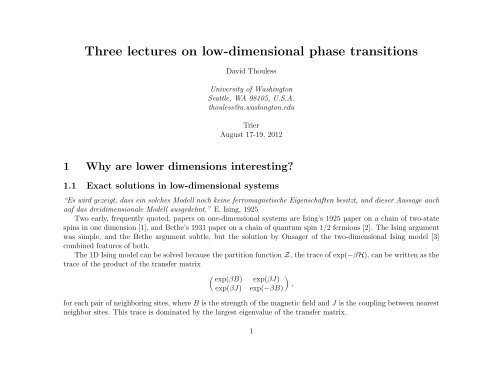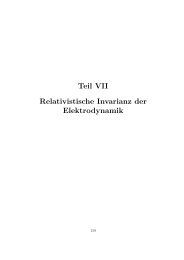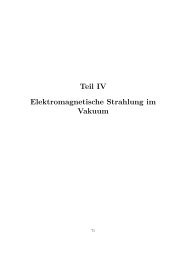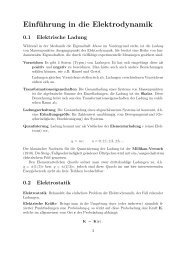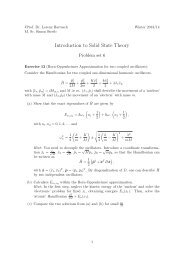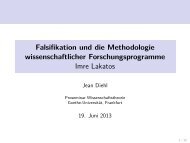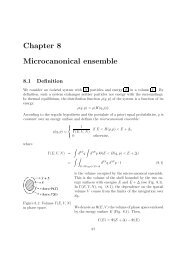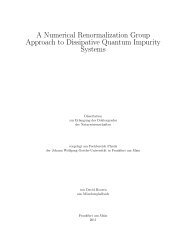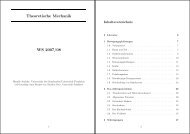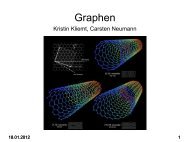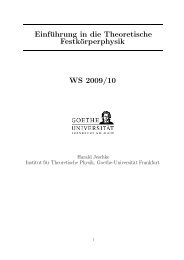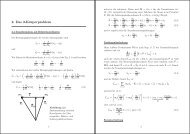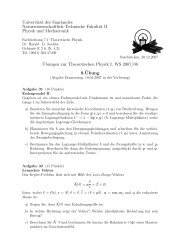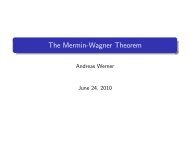Lecture Notes - Condensed Matter Theory Group
Lecture Notes - Condensed Matter Theory Group
Lecture Notes - Condensed Matter Theory Group
You also want an ePaper? Increase the reach of your titles
YUMPU automatically turns print PDFs into web optimized ePapers that Google loves.
For the two-dimensional Ising model the same sort of formalism has been used, but it is much more complicated,<br />
because the transfer matrix has to be written in terms of the relation between the states of successive columns of the<br />
spins. The exact solution of this was a major struggle. According to a talk by E. Montroll that I once heard, Onsager<br />
steadily increased the number of columns he included until he could guess the form of the answer and check that it<br />
was correct. This left other people in the field constructing simpler arguments, a few of which are compact enough<br />
to include in text-books.<br />
There is a similar additional level of complication involved in Bethe’s exploration of the eigenstates of the onedimensional<br />
chain of Heisenberg spins. The method which was used to solve this one-dimensional quantum problem<br />
is known as the Bethe ansatz, and this method has been heavily quoted since 1970. I found over 2800 papers that<br />
have used this phrase since then.<br />
In 1936 Peierls produced a proof, faulty in detail but using a powerful method, that the two- and three-dimensional<br />
Ising models are magnetized at low temperatures [4], and so we know that Ising’s statement was false.<br />
1.2 What else is known about critical phenomena?<br />
Claims of exact solutions of the three-dimensional Ising model have emerged occasionally, but none has survived<br />
close scrutiny. The model can be studied experimentally by finding uniaxial magnetic systems, or by analysis of high<br />
temperature power series for the properties of an ideal Ising model.<br />
Sceptics thought that low-dimensional systems were uninteresting, because real materials live in a three-dimensional<br />
world. Singular behavior of the specific heat and related quantities was a feature of many early experimental results,<br />
dating back to the 1870s, which had often been ignored, or, worse still, distorted to fit the results of the beautiful<br />
van der Waals theory. There was also an apparently careful analysis of bulk liquid helium close to the superfluid<br />
transition, which was incorrectly fitted to the logarithmic singularity of the two-dimensional Ising model by FBK.<br />
From 1960 onwards experimentalists, using careful analysis of measurements, and theorists, analysing high temperature<br />
and low field expansions of simple models, turned to a serious empirical study of the neighborhoods of critical<br />
points. It emerged that there were a limited number of universality classes, each with characteristic values of the<br />
critical exponents. Gas-liquid critical points, which were first studied by Thomas Andrews, share a universality class<br />
with the three-dimensional Ising model, and with the ordering transition of β brass, a 50% mixture of copper and zinc<br />
atoms. The exponents for the two-dimensional Ising model have been found for adsorbates on suitable substrates,<br />
2
such as graphite, and experimental results are close to calculated values.<br />
A common method of fitting a high temperature power series is to use Pade approximants, which are a succession<br />
of ratios of two power series designed to fit the original power series or its logarithm. This can lead to an accurate<br />
determination of the leading singularity of the free energy at the critical point of the phase transition.<br />
A revolutionary approach to such problems was introduced in 1972 by Kenneth Wilson and Michael Fisher at<br />
Cornell University. The title of the paper is “Critical exponents in 3.99 dimensions” [5]. For many systems, 4<br />
dimensions is where mean field gaussian behavior sets in, and the title expressed a hope that a perturbation away<br />
from 4 dimensions can lead to an understanding of what happens in 3 dimensions, or maybe even in 2 dimensions.<br />
This led to an explosion of work on critical phenomena and on related phenomena in quantum field theory.<br />
Mostly it worked well, but there were special difficulties with the three-dimensional Ising model. It turned out<br />
that at three dimensions there were confluent singularities rather than simple poles, so extrapolation required much<br />
more care. Bernie Nickel [6] and John Rehr [7] were two of the people who sorted this out.<br />
It was also not easy to extrapolate away from known two dimensional solutions, but this provided an additional<br />
method of studying the critical behavior of three-dimensional systems.<br />
1.3 Real systems with reduced dimensionality<br />
A sample with rectangular faces behaves two-dimensionally when the temperature is such that the correlation length<br />
is long compared with the thickness, but short compared with the width and breadth.<br />
A long sample with small regular cross-section can be one-dimensional if correlations are strong across the crosssection,<br />
but die off along the length.<br />
There are various ways of approaching one or two-dimensional systems without reducing the number of atoms so<br />
much that the signals an experimenter needs to measure are too small to measure accurately.<br />
Many layers with varying width of intercalating layers, eg. in graphite. Mildred Dresselhaus [8] has been one of<br />
the leaders in the study of intercalated graphite, and was recently awarded the Kavli Prize for her work on graphite.<br />
Multiple layers of graphene with varying separation, are used to approach the independent layer limit, while<br />
maintaing a strong total signal.<br />
Similar things can be done with multiple magnetic layers of varying separation. There was a good review in 1974<br />
by de Jongh and Miedema [9].<br />
3
There can be complicated interconnections across sample, as for helium films in vycor glass [10] or in gels. Does<br />
the complicated interconnectivity make it a bulk sample with holes in it? Studies of superfluid helium in such<br />
environments by Moses Chan show that the behavior in such multiply connected thin films is like that of bulk<br />
materials, but the superfluid transition occurs at a much lower critical temperature.<br />
Cold atoms allow large increase in signal strength per atom, by using resonant samples with narrow line-width.<br />
1.4 Dimensionality in superconductors<br />
Superconductors have a lot of interconnected coherence lengths involved. Mean free path of electrons, size of electron<br />
pair, penetration depth of magnetic field, etc.<br />
In 1936 it was discovered by Shubnikov and colleagues [12, 13] that superconductors could be divided into two types.<br />
The Type I materials were mostly clean materials in which the magnetic field was expelled from the superconducting<br />
regions, while Type II materials were mostly alloys (apart from pure niobium and vanadium), and the magnetic field<br />
coexisted with superconductivity.<br />
Shubnikov was killed, and the community had more urgent problems to think about for the next ten years, until<br />
the theory was rediscovered by Pippard, Gorkov, and others.<br />
Superconducting magnets have to be made from Type II materials. There is phase separation between the magnetic<br />
regions and the superconducting regions.<br />
Cuprate superconductors are strongly type II.<br />
1.5 Electronic devices and memory units<br />
Most electronic devices made in the past fifty years are based on transistors in which the electrons are trapped on a<br />
plane interface. Good GaAs device has long electron mean free path, which is why your cell phone can pick up a tiny<br />
signal.<br />
The giant magnetoresistance units used for memory devices in the past twenty years or so also need plane geometry<br />
for easy read-out.<br />
4
2 <strong>Theory</strong> of BKT transitions: 1. Early work<br />
2.1 Line defects and phase transitions<br />
In Onsager’s 1949 31-line “Observation” [14] he states, among other things, that circulation in superfluids is quantized<br />
in multiples of h/mA, where mA is the atomic mass, and that the circulation can either be round a solid obstacle or<br />
round a line singularity within the superfluid. He also says “As a possible interpretation of the λ-point, we can understand<br />
that when the concentration of vortices reaches the point where they form a connected tangle throughout the<br />
liquid, then the liquid becomes normal.” It should be no surprise that Onsager’s results were not widely appreciated<br />
until Feynman rederived them four or five years later [15].<br />
A similar suggestion has been made about the melting of solids, that a tangle of dislocations might form spontaneously<br />
at the melting temperature. This theory is discussed in Nabarro’s <strong>Theory</strong> of Crystal Dislocations (Oxford,<br />
1967), pages 688-691.<br />
As far as I know, there is no compelling model based on defect driven phase transitions in three dimensions. The<br />
statistical mechanics of line defects is complicated, and this is an obstacle to making a detailed theory.<br />
2.2 One-dimensional Ising model with long-range interactions<br />
What happens for the one-dimensional Ising model with a 1/r 2 interaction between spins? This question was posed<br />
to me by Phil Anderson, whose work on the Kondo effect depended on this [16, 17]. It was known, from work by<br />
Ruelle and by Dyson [18, 19], that there is no phase transition if the interaction falls off faster than 1/r 2 and there<br />
is a magnetized state if the fall-off is significantly slower than this.<br />
On the last page of Landau–Lifshitz Statistical Physics [20] there is an argument for the impossibility of having<br />
different phases in one-dimensional systems, and this argument can be modified for the case of long range interactions.<br />
In a system of length L with 2p domain walls, the entropy is<br />
S ≈ kBp ln(L/a) , (1)<br />
where a is the spacing between spins. In the particular case of a Ja 2 /r 2 interaction between spins, the energy of a<br />
5
There are close analogies between the vortex pairs in superfluid films, and the domain wall pairs in the long-range<br />
one-dimensional Ising model. In the low-temperature phase vortex pairs and domain wall pairs remain bound. In the<br />
high temperature phase there are unpaired vortices and unpaired domain walls that can move to destroy long range<br />
superfluid order or magnetic order. There is one important difference which is that we know no physical system that<br />
behaves like the long-range Ising model, but we know that low temperature liquid helium films are superfluid.<br />
I tried to persuade an experimentalist friend to measure this, but he told me that the measurements had already<br />
been made, the discontinuity had been seen, but more careful analysis had made the discontinuity in superfluid density<br />
disappear. The moral I would draw from this story is that experimenters should not seek too carefully for agreement<br />
with existing theory, nor should theorists seek too carefully for agreement with known experimental results. I was<br />
pleased when I heard Joe Vinen rebuke a member of his group who quoted agreement with theory as a sign of the<br />
accuracy of his measurements.<br />
A rigorous argument for the discontinuity of superfluid density was given by Fröhlich and Spencer [32], just before<br />
their paper about the one-dimensional magnet.<br />
If we regard the isolated vortex, or the isolated domain wall, as a monopole, and bound pairs as dipoles, the low<br />
temperature phase, in both the one-dimensional and two-dimensional cases, is a phase with no free monopoles, while<br />
the high temperature phase has an equilibrium distribution of free monopoles. As the temperature approaches the<br />
critical temperature for free monopoles from below, the typical size of dipoles increases, and diverges at the critical<br />
temperature. A renormalization group theory of this transition, modeled on the theories developed for more familiar<br />
critical points, was developed by Kosterlitz in 1974.<br />
In the low temperature phase of the superfluid the addition of potential flow to the system changes the equilibrium<br />
configuration of the vortices, and may cause flow of the vortices if there are not enough pinning centers for the vortices,<br />
but it does not cause dissipative transfer of energy to the phonon–roton system. Above the critical temperature energy<br />
is transferred to the phonon–roton system by moving positive vortices relative to negative vortices.<br />
8
2.4 Experimental tests of the theory<br />
The critical temperature at which some vortex pairs break up into two free vortices was predicted to be given by<br />
kBTc = πρs(¯h/MA) 2<br />
which is an equation with no free parameters. Experimental confirmation or correction of this relation required<br />
measurements of the temperature dependence of the superfluid density of helium films. One basic method was<br />
suggested by Landau and developed by Andronikashvili, which involved a stack of coaxial discs mounted in a cylinder<br />
filled with helium. The cylinder was suspended on a torsion fiber, and the oscillation frequency and damping rate<br />
were measured as a function of temperature. Above the critical temperature for superfluid onset, viscosity ensures<br />
that the fluid moves with the cylinder and discs, but below the critical temperature the moment of inertia drops,<br />
because the superfluid component does not follow the rotational motion of the apparatus. This allows the superfluid<br />
density to be measured as a function of temperature.<br />
The use of a nonzero frequency makes the measurement of moment of inertia much more sensitive, but broadens the<br />
transition between superfluid and normal fluid behavior: the nonzero frequency theory was derived by Ambegaokar<br />
et al. [33]. Bishop and Reppy [34] used a roll of Mylar film rather than coaxial discs to maximize the inertia of the<br />
helium film relative to the substrate. The response of the mylar roll to a periodic drive was measured under varying<br />
loads of condensed helium gas on the film. The Mylar film was about 6 µm thick and 21 m long, and was driven at<br />
2.5 kHz. The nonzero drive frequency increases the sensitivity of measurement, but leads to a raising of the transition<br />
temperature and broadening of the peak in attenuation at the transition.<br />
The results of this experiment are plotted together with the results from third sound measurements, and can be<br />
seen on the next page. In the upper right corner can be seen plots of the damping and frequency plotted against<br />
temperature, compared with the nonzero frequency predictions of ref. [33], which give a broadened peak in the<br />
damping, and an upward shift in the apparent transitions temperature. In the bottom left corner are shown a<br />
comparison of these results for the dependence of transition temperature on film thickness, both for this experiment<br />
and for three different third sound experiments, which shows good agreement with the parameter-free prediction.<br />
9<br />
(8)
3 BKT transitions: Later developments<br />
We had written about some other possible applications of the theory, some of which were right, and some seriously<br />
wrong. The analogy of a vortex pair to a classical electric dipole which could either be bound or ionized was helpful<br />
to our thinking, as we had learned about such things when we were undergraduates, studying the theory of dielectrics<br />
and electrical conductors.<br />
3.1 Planar magnets<br />
The parallel case of a planar magnetic system with a preferred plane of polarization is important theoretically, since,<br />
in renormalization group analyses in the style of Wilson and Fisher, magnetic systems are often used in the definition<br />
of universality classes. However, for the bosonic fluid we do not usually expect breaking of U1 symmetry (uniform<br />
change of the phase of the wave function), but in real planar magnets there are crystal symmetries which break the<br />
rotational symmetry about the z-axis. There are therefore important studies of the relevance or irrelevance of such<br />
symmetry breaking terms in such magnetic systems.<br />
3.2 Superconductors<br />
Perversely we argued that a superconducting thin film should not display an abrupt transition, because the interaction<br />
between vortices is modified at large distances by screening of the magnetic field, which leads to a finite penetration<br />
depth for the field. We should have remembered that this penetration depth is very large in thin films, so that<br />
modification of the theory by the screening is unimportant. This was pointed out by Beasley, Moij and Orlando in<br />
1979 [35]. Early experimental verification was published by Hebard and Fiory in 1983 [36].<br />
3.3 Solids, hexatic liquid crystals and liquids<br />
One of the most important errors that we made was to assume that the two-dimensional melting transition was<br />
equivalent to the superfluid transition, with edge dislocations taking the place of quantized vortices. This error was<br />
pointed out by Halperin and Nelson [37]. A concentration of free edge dislocations destroys the long range positional<br />
order of a solid, so that the Bragg peaks of X-ray scattering are smeared out.<br />
10
The figure on the previous page shows a single dislocation in a triangular lattice, which is characterized a pair of<br />
neighboring atoms, one of which has seven neighbors and the other five, whereas most atoms have six neighbors. A<br />
single dislocation, or a low concentration of randomly oriented dislocations, does not change the overall orientational<br />
symmetry of the crystal. It does, however, destroy its translational symmetry, so that the Bragg peaks in X-ray<br />
scattering are no longer sharp. The dislocation is characterized by its Burgers vector, which can be found by trying to<br />
draw a regular hexagon from neighbor to neighbor around the dislocation. The Burgers vector is the gap between the<br />
two ends of this construction. For the dislocation shown in the diagram the Burgers vector is one nearest neighbor<br />
spacing in the vertical direction.<br />
At low temperatures, dislocations are bound to one another in pairs, and the interaction between them has an<br />
angular dependence, unlike the isotropic interaction between vortices in superfluids; this is the true solid phase. Above<br />
the lowest critical temperature the dislocation pairs or triplets (for the case of three dislocations whose Burgers vectors<br />
add up to zero) dissociate to form a gas of free dislocations.<br />
A nonzero concentration of dislocations destroys the positional order characteristic of a crystal (sharp Bragg peaks<br />
in the X-ray scattering pattern), but does not destroy the orientational order of the crystal. Halperin and Nelson<br />
called this state of matter with orientational order but no positional order a hexatic liquid crystal. There are materials<br />
in which such transitions occur.<br />
A second, higher temperature transition may occur, in which pairs of disclinations (atoms with five or seven<br />
neighbors) dissociate to form a gas of disclinations. Such disclinations give local regions of seven- or five-fold symmetry,<br />
and so do destroy the overall crystal anisotropy, to produce a phase with the overall symmetry of a liquid.<br />
3.4 Roughening of crystal facets<br />
In 1976, Chui and Weeks found that the roughening of a facet of a three-dimensional crystal was a phase transition<br />
in the same class as the superfluid to normal transition in a helium film. This was a surprise, because the obvious<br />
representation of the facet free energy does not make this apparent. The two-dimensional Fourier components of the<br />
height of the interface from the ideal plane facet can be used to express the energy of a particular configuration of<br />
the interface, and this can be used to express the free energy as a gaussian integral, but a further change of variables<br />
must be made to bring it into the form which arises naturally in the other examples we have considered.<br />
11
3.5 Final remarks<br />
Michael Kosterlitz remained active in this area considerably longer than I did. Our last published joint work was a<br />
review in 1978 of two-dimensional physics published in Progress in Low Temperature Physics. Recently we contributed<br />
a chapter for a volume to be published by World Scientific Publishing Company, edited by Jorge Jose, on Forty Years<br />
of BKT <strong>Theory</strong>.<br />
Acknowledgements<br />
Firstly I want to acknowledge the teaching, guidance and friendship I have received over the past fifty years from Phil<br />
Anderson and Joe Vinen. Secondly, I owe a great deal to my friend and collaborator Mike Kosterlitz, who usually<br />
paid more attention to the details than I did. Thirdly, I want to thank the large number of people who took our<br />
ideas seriously, and turned our sometimes disjointed thoughts into real physics, particularly John Reppy and David<br />
Bishop, who did the right experiment at the right time, and those theorists who gave us great support in the early<br />
days, David Nelson, Michael Fisher, Jorge Jose, Leo Kadanoff, Scott Kirkpatrick, Bert Halperin, Vinay Ambegaokar,<br />
Eric Siggia, and many others.<br />
I deeply regret never having had the opportunity to meet the physicist who got there before us, Vadim Berezinskii.<br />
References<br />
[1] E. Ising, Z. Phys. 31, 253 (1925)<br />
[2] H. Bethe, Z. Phys. 71, 205 (1931)<br />
[3] L. Onsager, Phys. Rev. 65, 117 (1944)<br />
[4] R. Peierls, Proc. Cambridge Phil. Soc. 32, 225 (1936)<br />
[5] K. G. Wilson and M. E. Fisher, Phys. Rev. Lett. 28, 240 (1972)<br />
12
[6] B.G. Nickel and B. Sharpe, J. Phys. A, 12, 1819 (1979)<br />
[7] J.J. Rehr, J. Phys. A, 12, L179 (1979)<br />
[8] M.S. Dresselhaus, and G. Dresselhaus, Advances in Physics, 23, 1, (2002)<br />
[9] L.J. de Jongh and A.R. Miedema, Advances in Physics, 23, 1-260 (1974)<br />
[10] M.H.W. Chan, Physica B 169, 135 (1991)<br />
[11] J.M.H. Levelt Sengers, B. Kamgar-Parsi, F.W. Balfour, J.V. Sengers, J. Phys. Chem. Reference Data, v 12, n 1,<br />
1-28 (1983)<br />
[12] J.N. Rjabinin and L. W. Schubnikow, Phys. Zeits. Sowietunion 7, 122-5 (1935)<br />
[13] L.W. Schubnikow, W.I. Chotkewitsch, J.D. Schepelew and J.N. Rjabinin (1936). Phys. Zeits. Sowietunion 10,<br />
165-92 (1936)<br />
[14] L. Onsager, Nuovo Cimento 6, Suppl. 2, 249 (1949).<br />
[15] R. P. Feynman. In Progress in Low-Temperature Physics 1, pp. 17-53, ed. C. J. Gorter, North-Holland, Amsterdam<br />
(1955).<br />
[16] P. W. Anderson and G. Yuval, Phys. Rev. Lett. 23, 89(1969).<br />
[17] D. R. Hamann, Phys. Rev. Lett. 23, 95(1969)<br />
[18] D. Ruelle, Commun. Math. Phys. 9, 267(1968).<br />
[19] F. J. Dyson, Commun. Math. Phys. 12, 91(1969).<br />
[20] L. D. Landau and E. M. Lifshitz, Statistical Physics (Pergamon Press, Ltd., London), p. 482 (1958).<br />
[21] D. J. Thouless, Phys. Rev. 187, 732(1969).<br />
13
[22] F. J. Dyson, Commun. Math. Phys. 21, 269(1971).<br />
[23] J. Fröhlich and T. Spencer, Commun. Math. Phys. 84, 87(1982).<br />
[24] D. Rapaport and N.E.Frankel, Phys. Lett. A, 28a, 405 (1968)<br />
[25] J.F. Nagle and J.C. Bonner, J Phys. C 3, 352(1970).<br />
[26] J. M. Kosterlitz and D. J. Thouless, J. Phys. C: Solid St. Phys. 5, L124(1972).<br />
[27] J. M. Kosterlitz and D. J. Thouless, J. Phys. C: Solid St. Phys. 6, 1181(1973).<br />
[28] D. R. Nelson and J. M. Kosterlitz, Phys. Rev. Lett. 39, 1201(1977).<br />
[29] V. L. Berezinskii, Zhur. Eksp. Teor. Fiz. 61, 1144(1971);Sov. Phys. JETP, 34, 610(1971).<br />
[30] J. M. Kosterlitz, J. Phys. C: Solid St. Phys. 7, 1046(1974).<br />
[31] J.V. Jose, L.P. Kadanoff, S. Kirkpatrick and D.R. Nelson, Phys. Rev. B 16, 1217-41 (1977).<br />
[32] J. Fröhlich and T. Spencer, Commun. Math. Phys. 81, 527(1981).<br />
[33] V. Ambegaokar, B.I. Halperin, D.R. Nelson and E.D. Siggia, Phys. Rev. Lett. 40, 783 (1978)<br />
[34] D.J. Bishop and J.D. Reppy, Phys. Rev. Lett. 40, 1727 (1978)<br />
[35] M.R. Beasley, J.E. Mooij and T.P. Orlando, Phys. Rev. Lett., 42, 1165 (1979)<br />
[36] A.F. Hebard and A.T. Fiory, Phys. Rev. Lett., 50, 1603 (1983)<br />
[37] B. I. Halperin and D. R. Nelson, Phys. Rev. Lett. 41, 121 (1978)<br />
14


